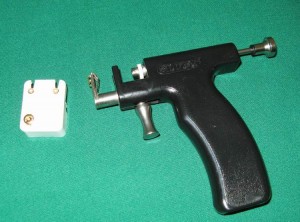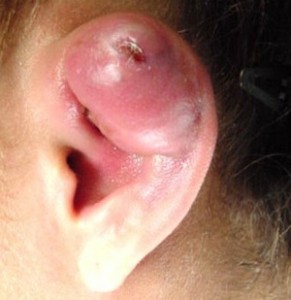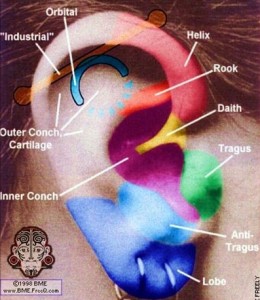The trend of getting the cartilage of the ear and the nose pierced for reasons dedicated towards becoming stylish and cool with a variety of accessories hanging on the nose and the ear has also been the reason for paying visits to the doctor owing to the ill effects of such ornamental practices. Most youngsters have always liked to flaunt trendy accessories and earrings in order to look cool and sexy. But once they feel the pinch and the pain that follows piercing, they realize the importance of the famous phrase “no pain- no gain”. It has been observed that poor and unhygienic ways of piercing causes swelling and infection of the ears or the nose and causes pain in the affected areas. Extreme conditions may lead to cartilage piercing infections causing the development of abscess containing puss. Moreover this may be coupled with the development of scars and the formation of bumps in the ear and the nose. So it’s imperative to have the right cartilage piercing information and the knowledge of its procedures as to be away from such problems of pain and suffering.
Scientifically cartilage piercing infection has been found to be primarily caused by the pathogen named Staphylococcus aureus but it may also be caused by Pseudomonas aeruginosa which if left untreated has the ability to cause a permanent ear deformation, a condition also known as auricular chronditis. There are a number of other factors of infected cartilage piercings:-
- Swimming in waters of lakes, ponds which are stagnant and contaminated usually causes infections by the pathogen named Pseudomonas.
- disinfectants contaminated with such species of bacteria as well as benzalkonium chloride used as antiseptic in hospitals are also the sources of infection.
- The improper use of piercing guns, needle, jewelery or other methods of piercing using metals may also amount to infections.
- Improper techniques of incision, splinting and drainage are the primary causes of cartilage infection and swelling.
Types of Ear Cartilage Piercing
Page Contents
The cartilage belonging to the ear is thicker than the skin on the neck or the forehead. The ear is usually pierced by a sterilized needle so as to refrain from any act that may cause infection. Certain ornaments help in the process of piercing like the bead rings which being large allow better absorption of air facilitating the process of healing. However doctors prefer the use of stainless jewellery such as those made of gold, platinum, diamond and titanium and do not encourage the use of artificial earrings. On the basis of the type of jewellery one would like to carry on the ear and the nose, ear piercing may be divided into a number of types. Some of the types of ear cartilage piercing are mentioned as the following:-
Picture 1 – Types of Ear Cartilage Piercing
Source : 3.bp.blogspot
- The ear lobe piercing is the most common type of ear piercing. It is conducted on that part of the ear which is free from cartilage and as such lacks elasticity. The earring accessories are usually found to dangle on the ear lobe. It is the least painful part and also takes the minimum duration of time to heal, usually a month.
- The piercing of the helix which is the part of the upper ear cartilage, used for the task of ornamentation is usually done with a small gauged hollow piercing needle or a cartilage piercing hoop or a stud. The pierced portion of the helix takes around six to eight months to heal. But it is also a sensitive area which requires a proper and prompt handling for the purpose of piercing.
- When the helix of the ear is perforated twice so as to hold the same or different jewelery piece, we term the process as Industrial ear piercing which has a year long period to heal. Professional expertise is required to pierce the ear at the helix as it is also a very sensitive area.
- Conch piercing is a process of ear piercing which happens to be of two types, namely outer conch piercing and the inner conch piercing. The outer conch piercing is performed at the outer rim of the ear cartilage and the inner conch piercing takes place at the center of the ear cartilage. This type of piercing method does not take much time to heal, at the most six to eight months only.
- Another type of piercing is conducted at the thick fleshy fold of the ear called the tragus which is actually very painful in nature and takes a long time, not less than 4 months to heal. Read more on Tragus Piercing.
- Another variant to piercing is the Anti-tragus piercing which is conducted above the ear lobe at the part opposite the tragus. Ball closure rings and other micro jewelery are best suited for this purpose. It may take around two and a half months to heal.
- The uppermost part of the ear which is very thick and is above the tragus is perforated using sterilized needles and this type of ear piercing method is known as the Rook piercing. Being loaded with a mass of flesh, the piercing of this part is extremely painful and may take months or a year to heal completely.
- Daith piercing is carried out on the fold of the cartilage closest to the ear canal. Its healing duration extends from six to eight weeks and micro jewelery and ball closure rings are the most sought after for this purpose.
- Another kind of ear piercing called the Dermal Punch Piercing is performed on either the ear lobe or the flat portion of the cartilage. It derives its name from the way it is conducted by punching out or extracting a round flesh piece of the ear and creating a large hole which shall hold the jewelery. The healing time depends on the area of ear piercing. If it pierced on the ear lobe it takes around 4-6 weeks to heal but a pierce on the cartilage may take more time to heal and may also be more painful than the former.
How to pierce your Cartilage?
There are many ways of getting cartilage pierced as mentioned above but there are also some procedures to follow in order to ensure proper cartilage piercings. Some of those suggested by doctors are as follows:-

Picture 2 – Cartilage Piercing Gun
Source : drpaulose
- Firstly you need to wash and rinse the hands properly with an anti-bacterial soap.
- There is a need to sterilize the needle to be used for piercing with warm soapy water and alcohol in the second place.
- Thirdly you need to damp the piercing needle with water and put a few drops of anti-bacterial soap over until lather forms with the help of a cotton bud.
- Any kind of crusted discharge must be loosened and removed from the jewelery & the surface of the skin with the help of a cotton bud.
- In the fourth step, you need to keep the anti-bacterial soap on the piercing needle or tool for two minutes and rotate the jewelery back and forth so that the disinfectant penetrates down to the area pierced.
- Lastly you require to properly rinse the area with water and leave it free and untouched to dry. Any kind of fidgeting trial to wipe the area pierced with a hanker-chief or a towel may cause bacterial infection.
Getting your cartilage pierced necessitates the careful maintenance of personal hygiene and the proper sterilization of tools, jewelery and equipments in order to avoid any chance of cartilage infections. You should also be careful while choosing the tools and equipments as poor quality stuff may harm the cartilage and cause infections. Along the same lines, the process of cleaning cartilage piercing and its after care must also be followed sincerely.
Dangers and Risks of Cartilage Piercing
Piercing the cartilage also has its perils which may take place in two different ways, namely
Cartilage Piercing Infection
Infected cartilage piercing are caused by a number of factors such as :
- The use of piercing equipments of a poor quality or using dirty tools.
- Frequent fidgeting of the area pierced with dirty hands.
- To wear tight earrings or accessories of a poor quality.
- Improper ways of piercing.
- Unhygienic cartilage piercing methods.

Picture 3 – Cartilage Piercing Infection
Source – girlishh
All these may expose the pierced area to bacterial infections whose symptoms include the discharge of a yellowish fluid from the pierced area, cartilage irritation, a burning sensation accompanied with pain in the area, reddening of the pierced area or cartilage piercing swelling.
However, there are ways to fight against cartilage infections by applying a solution of warm water and non-iodized salt on the infected area for 4-5 times a day. While applying the same you may also rub ice-cubes on the ear in a gentle manner. Another way of dealing with cartilage infections is to apply a cotton ball soaked in a solution of sea-salt or Epsom salt for five minutes twice daily. But you should be careful to observe that the infection does not take a serious turn in which case one needs to consult a physician without delay.
Scarring
The inexperienced piercing of the cartilage may cause harm to the tissues which may lead to the formation of scars in and around the pierced area. This facilitates the formation of a bump or a ridge over the pierced area which may bleed at times. For the cure of an infection caused to that extent you need to consult your physician who shall be able to offer the best treatment for the same.
In order to avoid such infections you need to ensure proper piercing and after care measures of cartilage piercing.
Cartilage Piercing Healing
Usually a cartilage piercing infection takes 3-12 months to heal but it may vary on the basis of the kind of cartilage piercing that you undergo, the extent of cartilage piercing as well as the area getting pierced. Here is a list of measures that you need to follow for the fast and complete healing of the cartilage piercing infection and scarring:-
- Any kind of contact of the affected area with the unhygienic components in the environment should be avoided.
- It is mandatory to clean the pierced area at least once daily.
- The affected area should not be allowed to get submerged into puddles or pools of dirty rain water during the healing period.
- Anti-bacterial soaps containing triclosan and chloroxylenol should be used in the cleaning process of cartilage piercing. In no cases should tea tree oil, hydrogen peroxide, Betadine or alcohol swabs be used to clean the same as they may prove to be harmful.
- You should also avoid the use of beauty creams and other cosmetic items while the healing process is on.
- The over-cleaning of the pierced area must also be avoided as it may cause an irritation of the area.
- The cartilage piercing jewellery must be worn till the pierced area gets healed.
- Lavender oil must be used for the better healing of the pierced area as it acts as a lubricant for cartilage piercing & helps in the healing of the scars and prevents tightening.
- Vitamin C & Zinc tablets and other substitutes must be taken as they help in the fast healing of the pierced area.
- A mixture of aspirin tablets and lemon juice in the form of a paste should be applied on the bumps formed out of the cartilage piercing infections.
It is necessary for all to be patient enough to bear the pain and duration of the healing process as the slightest mistake may aggravate the duration and the extent of suffering. Moreover, you should be careful to ensure that the affected area has been treated completely as the pierced area may appear to be healed but the tissues within the cartilage may not actually heal. Carelessness of any kind may cause complications which may lead to the unusual discharge of fluids from the area. This may give rise to pain and reddening of the pierced area.
Hence, cartilages are very sensitive in nature and as such must be pierced by only a trained and a highly experienced piercer so that he/she can flaunt fashionable earrings and other accessories with slight pain but no suffering. However it is advisable to get treated by a dermatologist or an E.N.T specialist in case the situation worsens.


They need to be taken care of for life.. I keep my own cartilage piercings clean and yet sometimes find them sore or red.. my tip use neosporin and salt washes.. along with gold earrings. Sometimes silver and cheap earrings can help irritate the piercing.
Never ever ever should you ever have cartilage pierced with a gun! This causes the cartilage around the site to shatter which is some serious internal damage and will add months and months to the healing process